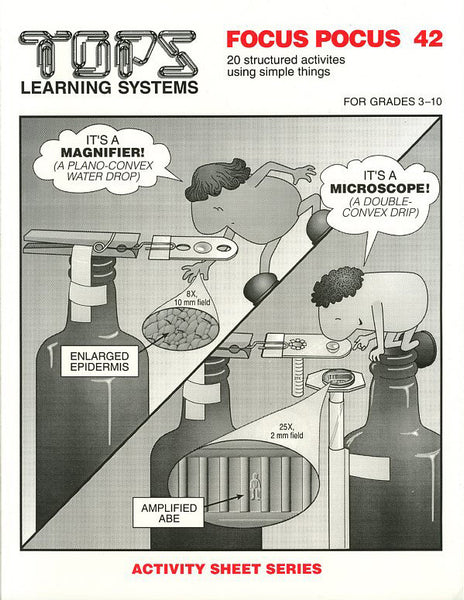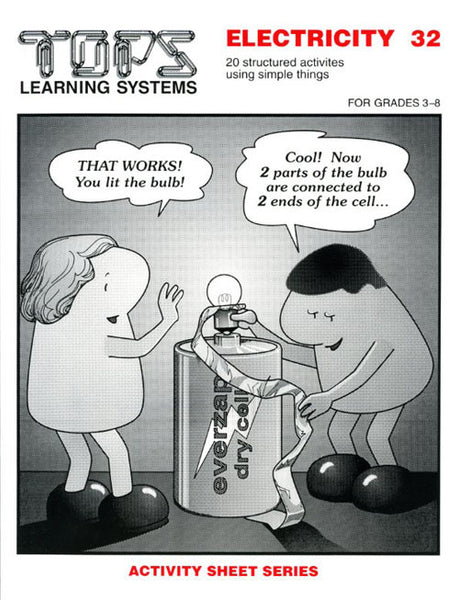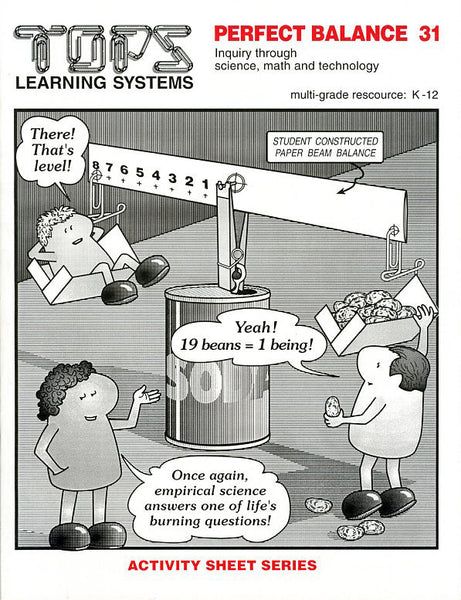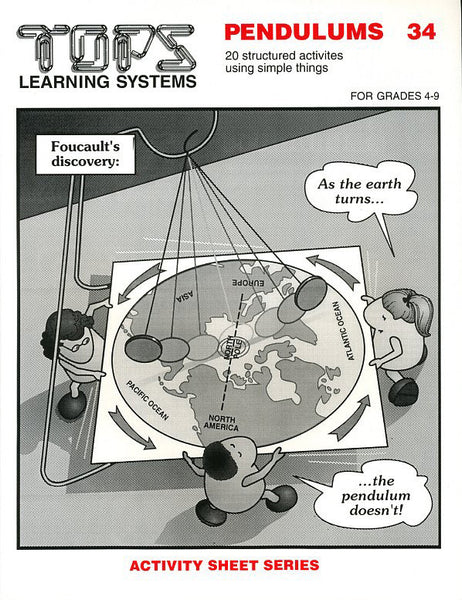#42 Focus Pocus (grades 5-10)
Regular price $23.95
1/15/15: scissors
* 4/60/60: microscope slides
* 0.1/1/1: cups modeling clay
* 6/90/90: straight pins, about 1 inch long
* 1/5/5: rolls 1/2 inch clear tape
1/5/15: metric rulers
1/8/15: sets assorted coins: 4 pennies, 1 nickel, 1 dime, 1 quarter
* 3/45/45: straight plastic drinking straws
* 1/5/5: rolls 3/4 inch masking tape
* 2/30/30: TOPS hand lenses or equivalent
2/30/30: glass bottles, soda or beer, about 20 cm tall
1/15/15: index cards
* 1/15/15: regular canning rings, not wide-mouth
1/1/1: roll plastic wrap
* 1/15/15: heavy rubber bands
* 1/15/15: dropper bottles
* 1/15/15: metal washers with 5/16 inch (8 mm) hole
1/1/1: box facial tissue, or roll toilet paper
* 4/60/60: paper clips
* 2/30/30: wooden clothespins
* 1/3/15: hand mirrors
1/15/15: empty cans, 2 7/8 inches in diameter by 4 3/8 inches tall; a common size for vegetables with 14.5 to 15.5 ounce net weights. A regular-size canning ring must nest inside without falling through. Choose cans that can be opened from both ends.
1/1/1: roll waxed paper
* 1/1/1: roll aluminum foil
* 1/5/15: candles with drip catchers
1/2/5: packages matches
1/10/15: meter sticks
* 1/1/1: roll adding machine tape
1/1/1: pencil sharpener
1/8/15: hand calculators (optional)
* 1/5/15: 1/16 inch diameter finishing nail
* 3/15/45: 1 1/2 inch nails
* 1/5/15: 2 1/2 inch nail
* 1/5/15: 3 1/2 inch nail
1/15/15: palm-sized pieces, clear, flat plastic from bakery "clamshell" cartons
1/2/5: hole punch
1/1/1: jar petroleum jelly
1/1/1: packages each: granulated sugar, table salt, pepper, whole poppy seeds
* 1/1/1: bottle glycerin (optional)
1/3/15: dark crayons or marking pen
various: samples printed matter: newsprint, 4-color magazine ads, computer printouts
1/15/15: wooden toothpicks
- Lesson 1: To track the path of light as it refracts through glass. To recognize that light bends more sharply as its angle of incidence increases.
- Lesson 2: To develop a model that demonstrates the direction light refracts as it passes from air to glass to air.
- Lesson 3: To understand why light rays bend inward when refracted through a convex lens. To focus light rays from a distant landscape as an inverted image on an index card screen.
- Lesson 4: To explore the relationship between the size of a water-drop lens and its focal length. To practice drawing accurate diagrams based on real measurements.
- Lesson 5: To vary the shape of a water lens from highly positive to highly negative curvatures. To examine how each lens shape refracts parallel light.
- Lesson 6: To study how the focal length of a convex lens varies with curvature. To understand why neutral and concave lenses do not project a focused image.
- Lesson 7: To study how different lens shapes magnify or reduce images. To interpret light ray diagrams.
- Lesson 8: To understand how pinholes focus light. To compare the properties of pinholes and lenses.
- Lesson 9: To construct an artificial eye, and determine whether it is farsighted or nearsighted. To understand how the human eye accommodates to both far and near vision.
- Lesson 10: To plot personal visual acuity as a function of distance. To discover the near limit of your eye's ability to accommodate.
- Lesson 11: To measure the apparent size of coins as subtended angles in your field of view. To observe how the apparent size of an object increases as its distance to your eye decreases.
- Lesson 12: To explore the inverse relationship between the distance of an object from your eye and the angle it subtends in your field of view. To appreciate the power of mathematics as a predictive tool.
- Lesson 13: To study the inverse relationship between the scale of an object and its distance from your eye. To evaluate the power of a hand lens.
- Lesson 14: To build a water magnifier and learn how to use it. To develop creative writing and drawing skills.
- Lesson 15: To build a microscope and learn how to use it. To investigate how the properties of a plano-convex lens change with size.
- Lesson 16: To investigate the optical properties of a "suspender lens" microscope. To describe and draw common kitchen spices at 25X magnification.
- Lesson 17: To accurately draw a pin 25X larger than actual size by measuring it under a microscope. To reduce this enlarged picture to actual size by observing it at a distance.
- Lesson 18: To examine printed type with a microscope. To understand how dotted "halftones" combine to produce all shades of grey plus a spectrum of color.
- Lesson 19: To use the pinhole like a magnifying lens. To compare the images produced by pinholes of various size.
- Lesson 20: To construct and use a van Leeuwenhoek microscope with tiny water lenses that magnify from, 60X to 100X. To begin an exploration of the world of small.
TEACHING Standards
These 20 Activity Sheets promote excellence in science teaching by these NSES criteria:Teachers of science...
A: ...plan an inquiry-based science program. (p. 30)
B: ...guide and facilitate learning. (p. 32)
C: ...engage in ongoing assessment of their teaching and of student learning. (p. 37)
D: ...design and manage learning environments that provide students with the time, space, and resources needed for learning science. (p. 43)
CONTENT Standards
These 20 Activity Sheets contain fundamental content as defined by these NSES guidelines (p. 109).• Represent a central event or phenomenon in the natural world.
• Represent a central scientific idea and organizing principle.
• Have rich explanatory power.
• Guide fruitful investigations.
• Apply to situations and contexts common to everyday experiences.
• Can be linked to meaningful learning experiences.
• Are developmentally appropriate for students at the grade level specified.
Unifying Concepts and Processes
NSES Framework: Systems, order, and organization • Evidence, models and explanation • Constancy, change, and measurement • Form and functionCore Concepts/Processes: Water drops are shaped like convex lenses. • Small water drops are powerful magnifiers with short focal lengths.
Science as Inquiry (content standard A)
NSES Framework: Identify questions that can be answered through scientific investigations. • Design and conduct a scientific investigation. • Use appropriate tools and techniques to gather, analyze, and interpret data. • Develop descriptions, explanations, predictions, and models using evidence. • Think critically and logically to connect evidence and explanations. • Communicate scientific procedures and explanations. • Use mathematics in all aspects of scientific inquiry.Core Inquiries: Inquire into the nature of light refraction and image magnification with water drops.
Physical Science (content standard B)
NSES Framework: Light, heat, electricity, and magnetism • Properties and changes of properties in matter • Motions and forces
Core Content: Light refraction • Divergent, parallel and convergent rays • Water drop magnification • Concave and convex water lenses • Focal distance • Lens curvature and magnification • Inverse size-distance relationship • Halftones • Printed colors • Pinholes
Life Science (content standard C)
NSES Framework: Structure and function in living systems
Core Content: Explore cellulose, hair, tiny seeds, insect parts, plant cells, and other living systems with water drop microscopes. • Model the human eye • Graph visual acquity
Earth and Space Science (content standard D)
NSES Framework: Properties of earth materials
Core Content: Explore salt crystals, sugar crystals, soil and other natural products with water drop microscopes.
Science and Technology (content standard E)
NSES Framework: Abilities of technological design • Understanding about science and technology
Core Content: Make a water-drop microscope. Explore the magnification properties of lens size and curvature. What are the trade-offs?
History and Nature of Science (content standard G)
NSES Framework: Science as a human endeavor • Nature of science • History of scienceCore Content: Build a powerful single-lens microscope modeled on an original design of Dutch naturalist Anton van Leeuwenhoek (1632-1723).






